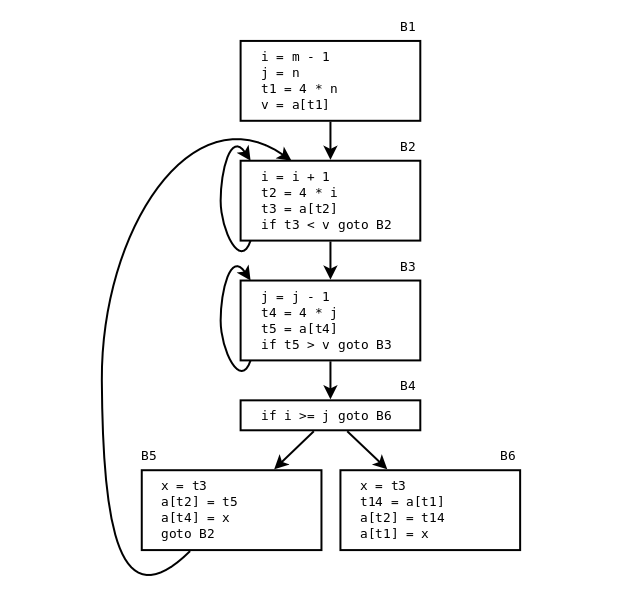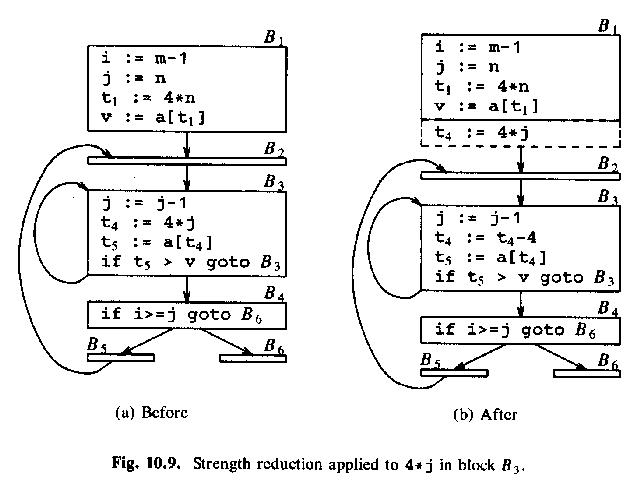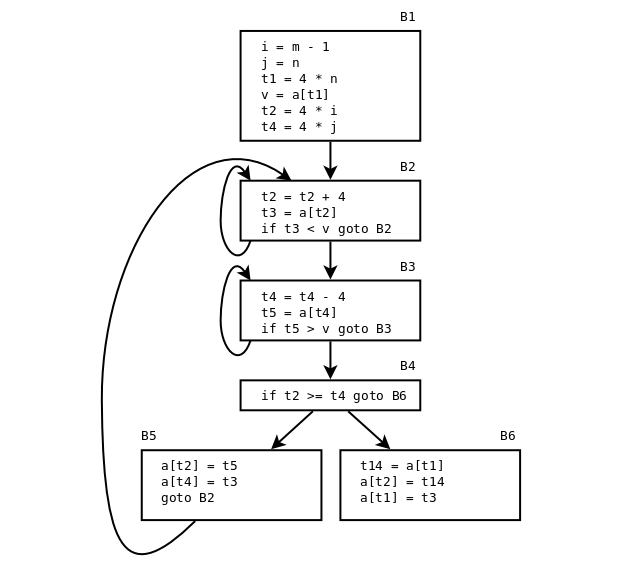
Det här är ungefär vad jag tänker säga på föreläsningen. Använd det för förberedelser, repetition och ledning. Det är inte en definition av kursinnehållet, och det ersätter inte kursboken.
Idag: Maskinoberoende optimering. Intermediärkod. Treadresskod.
Man menar egentligen inte "optimalt" (bästa möjliga), utan bara "bättre".
Det heter "optimization" på engelska, och "optimering" på svenska. Inte "optimisering"!
Normalt är det optimeringsfasen (-faserna) i kompilatorn som gör optimeringen, men det finns också "handoptimering", där programmeraren själv ändrar programmet. Ett exempel: i = i * 2 kan ändras till i = i << 2. Bitskiftning är en enklare operation än multiplikation, och kan på en del processorer vara snabbare.
Ett annat exempel:
for (i = 0; i < n; ++i) {
do_something(a[i]);
}
Ekvivalent med:
i = 0;
while (i < n) {
do_something(a[i]);
++i;
}
Kan "optimeras" till att stega fram en pekare,
och använda den som loopvariabel:
p = &a[0];
p_after = &a[n];
while (p != p_after) {
do_something(*p);
++p;
}
Men moderna kompilatorer kan sånt här!
Det blir förmodligen inte snabbare,
kanske till och med långsammare,
och koden blir svårläst och skör.
Görs bättre av den automatiska optimeraren i kompilatorn!
Two rules about optimization by hand:
|
Types of optimization:
Machine-dependent optimization is sometimes done using Peep-hole optimization (ALSU-07 8.7, ASU-86 9.9): Simple transformations of the generated assembly (or machine) code. Ex:
| can be changed to |
|
"Intermediate code" på engelsa. "Mellankod" eller ibland "intermediärkod" på svenska.
Why generate intermediate code? Why not do everything "in the Yacc grammar"? Some reasons:
Some ways to represent the program:
Men: Postfixkod är svårjobbat om man ska optimera.
Exempel på infixkod: 1*(a+2)*b
I ett syntaxträd är det ganska enkelt att hitta, och optimera bort, multiplikationen med 1.
(Görs i del B i
labb 7.)
Postfixkoden: 1 a 2 + * b *
Svårt att hitta multiplikationen med 1 i postfixkoden! Svårt att ta bort den!
Example: x + y * z
temp1 = y * z temp2 = x + temp2
Treadresskod har (högst) tre adresser i varje instruktion:
var1 = var2 operation var3
Note:
Treadresskod har högst tre adresser i varje instruktion. Fler typer:
var1 = operation var2
goto addr1
if var1 <= var2 goto addr3
Idea: Each internal node corresponds to a temp-variable!
Example: a = b * -c + b * -c (The tree in ASU-86 fig. 8.4a)
temp1 = - c temp2 = b * temp1 temp3 = - c temp4 = b * temp1 temp5 = temp2 + temp3 a = temp5
param temp4 param a param b call f, 3
Synthesized attributes:
E.addr = the name of the temporary variable
(kallades place i ASU-86)
E.code = the sequence of three-address statements that calculates the value
(or they could be written to a file instead of stored in the attribute)
| Production | Semantic rule |
|---|---|
| Start -> id = Expr | Start.code = Expr.code + [ id.addr ":=" Expr.addr ] |
| Expr -> Expr1 + Expr2 | Expr.addr = make_new_temp();
Expr.code = Expr1.code + Expr2.code + [ Expr.addr = Expr1.addr "+" Expr2.addr; ] |
| Expr -> Expr1 * Expr2 | Expr.addr = make_new_temp();
Expr.code = Expr1.code + Expr2.code + [ Expr.addr = Expr1.addr "*" Expr2.addr; ] |
| Expr -> - Expr1 | Expr.addr = make_new_temp();
Expr.code = Expr1.code + [ Expr.addr = "-" Expr1.addr; ] |
| Expr -> ( Expr1 ) | Expr.addr = Expr1.addr; // No new temp!
Expr.code = Expr1.code; |
| Expr -> id | Expr.addr = id.addr; // No temp!
Expr.code = ' '; // No code! |
(Se tabellen i ALSU-07 fig. 6.19, eller i ASU-86 fig. 8.15.)
While statement (very similar to generating stack machine code, see föreläsning 9):
| Production | Semantic rule |
|---|---|
| Stmt -> while ( Expr ) Stmt1 |
Stmt.before = make_new_label();
Stmt.after = make_new_label(); Stmt.code = [ "label" Stmt.before ] + Expr.code + [ "if" Expr.addr "==" "0" "goto" Stmt.after; ] + Stmt1.code + [ "goto" Stmt.before ] + [ "label" Stmt.after ]; |
(Se tabellen i ALSU-07 fig. 6.36, eller i ASU-86 fig. 8.23.)
| Op | Arg1 | Arg2 | result | |
|---|---|---|---|---|
| 0 | uminus | c | temp1 | |
| 1 | * | b | temp1 | temp2 |
| 2 | uminus | c | temp3 | |
| 3 | * | b | temp3 | temp4 |
| 4 | + | temp2 | temp4 | temp5 |
| 5 | := | temp5 | a |
Skip: Also "triples" (but they are hard to optimize) and "indirect triples" (as easy to optimize as quadruples, but more complicated).
"Basic blocks" används för optimering.
Ett par termer:

Fler termer:
Transformationer på basic blocks (kort, mer sen i exemplet):
| -> |
|
| -> |
|
| -> |
|
/* recursively sorts the array a, from a[m] to a[n] */
void quicksort(int m, int n) {
int i, j;
int v, x;
if (n <= m)
return;
i = m - 1; j = n; v = a[n];
while (1) {
do
i = i + 1;
while (a[i] < v);
do
j = j - 1;
while (a[j] > v);
if (i >= j)
break;
x = a[i]; a[i] = a[j]; a[j] = x; /* swap */
}
x = a[i]; a[i] = a[n]; a[n] = x; /* swap */
quicksort(m, j);
quicksort(i + 1, n);
}
Some optimizations are not possible on the source level.
Treadresskod för den fetmarkerade delen av quicksort-funktionen (ALSU fig. 9.2 eller ASU-86 fig. 10.4):
(1) i = m - 1 (16) t7 = 4 * i (2) j = n (17) t8 = 4 * j (3) t1 = 4 * n (18) t9 = a[t8] (4) v = a[t1] (19) a[t7] = t9 (5) i = i + 1 (20) t10 = 4 * j (6) t2 = 4 * i (21) a[t10] = x (7) t3 = a[t2] (22) goto (5) (8) if t3 < v goto (5) (23) t11= 4 * i (9) j = j - 1 (24) x = a[t11] (10) t4 = 4 * j (25) t12 = 4 * i (11) t5 = a[t4] (26) t13 = 4 * n (12) if t5 > v goto (9) (27) t14 = a[t13] (13) if i >= j goto (23) (28) a[t12] = t14 (14) t6 = 4 * i (29) t15 = 4 * n (15) x = a[t6] (30) a[t15] = x
Steps for the optimizer:
Basic blocks och flödesgraf för quicksort-funktionen (ALSU-07 fig. 9.3 eller ASU-86 fig. 10.5):

Three loops:
"Some of the most useful code-improving transformations".
Local transformation = inside a single basic block
Global transformation = several blocks (but inside a single procedure)
B5
| can be changed to |
B5
|
(Remove repeat calculations, use t6 instead of t7, t8 instead of t10.)
From ALSU-07 fig 9.4, 9.5:
(We can remove 4*i, 4*j, and 4*n completely from B6!)
Remove 4*i and 4*j completely from B5!
B5
| can be changed to |
B5
|
B5
| can then be changed to |
B5
|
Note: a hasn't changed, so a[t4] still in t5 from B3
B5
| can then be changed to |
B5
|
Blocken B5 och B6 efter att vi eleminerat både lokala och globala gemensamma deluttryck (ALSU-07 fig. 9.5 eller ASU-86 fig. 10.7):

B5
| can be changed to |
B5
|
B5
| but x is dead, so: |
B5
|
while (i < limit - 2)
a[i++] = x + y;
The expressions limit - 2 and x + y are loop-invariant.
The next example is harder for the compiler, since strlen is just another function. (Or is it?)t1 = limit - 2; t2 = x + y; while (i < t1) a[i++] = t2;
for (i = 0; i < strlen(s1); ++i) s2[i] = s1[i];
n = strlen(s1); for (i = 0; i < n; ++i) s2[i] = s1[i];
i = 0;
j = 1;
while (a1[i] != 0) {
a2[j] = a1[i];
++i;
++j;
}
Both i and j are induction variables ("loop counters").
i = 0;
while (a1[i] != 0) {
a2[i + 1] = a1[i];
++i;
}
B3
| blir |
B3
|
Men det där är fel, för nu får t4 inget startvärde. Men det kan vi fixa genom att peta in t4 = 4*j i block B1, som körs en enda gång (inte i B2, som körs en massa massa gånger):
ALSU-07 fig. 9.9 (ASU-86 fig 10.9):

Then a similar strength reduction of 4 * i in basic block B2.
We know that t2 == 4 * i. Maintain this relationship!
Then, i and j are used only in the test int B4.
The test
i >= j
can be changed to
4 * t2 >= 4 * t4
(which is equivalent to
t2 >= t4).
i and j become dead!
Flödesgrafen efter att vi eliminerat induktionsvariablerna i och j (ASU-86 fig 10.10 eller ALSU-07 fig. 9.9):

for (i = 0; i < 20; ++i)
for (j = 0; j < 2; ++j)
a[i][j] = i + 2 * j;
may be transformed by unrolling the inner loop:
for (i = 0; i < 20; ++i) {
a[i][0] = i;
a[i][1] = i + 2;
}
or by unrolling the outer loop too:
a[0][0] = 0;
a[0][1] = 2;
a[1][0] = 1;
a[1][1] = 3;
a[2][0] = 2;
a[2][1] = 4;
....
a[19][0] = 19;
a[19][1] = 21;
Man behöver inte rulla ut alla varven, utan man kan rulla ut bara en del av dem.
Varning: cachen! En för stor loop kanske inte får plats i processorns instruktionscache.
void f(struct Node *p) {
if (p == NULL)
return;
p->value++;
f(p->next);
}
void f(struct Node *p) {
while (p == NULL) {
p->value++;
p = p->next;
}
}
int a;
...
void f(string a) {
...
while (1) {
int a;
... <-- In the debugger: print a
}
}
What is needed, for symbolic debugging in general?
A program may work when unoptimized, but not when optimized. For example, the C standard specifies undefined behaviour in certain cases. such as:
The behaviour depends entirely on what happens to be stored at the memory location 5 bytes after the end of s: unused padding, a variable, or the return address in an activation record? This can be different with or without optimization, since optimization, for example, can eliminate variables.char s[10]; ... s[14] = 'x';
An example program:
#include <stdlib.h> #include <stdio.h> int plus(int x, int y) { int a[2]; int s; s = x - y; a[x] = x + y; return s; } int main(void) { int resultat; resultat = plus(-1, -2); printf("resultat = %d\n", resultat); return 0; }
Running it without optimization, and then with optimization (the "-O" flag):
Excercise for the reader: What happened? Can you deduce something about how the compiler laid out the variables in the activation record for the function "plus"?
linux> gcc -Wall plus.c -o plus plus.c: In function 'plus': plus.c:5:9: warning: variable 'a' set but not used [-Wunused-but-set-variable] int a[2]; ^ linux> ./plus resultat = -3 linux> gcc -O -Wall plus.c -o plus plus.c: In function 'plus': plus.c:5:9: warning: variable 'a' set but not used [-Wunused-but-set-variable] int a[2]; ^ linux> ./plus resultat = 1 linux>
Trying to debug:
linux> gcc -g -O -Wall plus.c -o plus plus.c: In function 'plus': plus.c:5:9: warning: variable 'a' set but not used [-Wunused-but-set-variable] int a[2]; ^ linux> ./plus resultat = 1 linux> gdb plus Some output from GDB removed (gdb) break main Breakpoint 1 at 0x400562: file plus.c, line 12. (gdb) run Starting program: /home/padrone/tmp/14okt/plus Breakpoint 1, main () at plus.c:12 12 int main(void) { (gdb) step 15 printf("resultat = %d\n", resultat); (gdb) print resultat $1 = <optimized out> (gdb)
ASU-86 fig 10.68. Assume that the source, intermediate and target representation are the same.

ASU-86 fig 10.69. A DAG for the variables. The DAG shows how values depend on each other. Then, annotate it with life-time information.

Example 1 (just the unoptimized program):
c = a + b after step 1. (Life time: 2-3)
c = c - e after step 3. (Life time: 4-infinity)
Example 2 (the optimized program):
c = a after step 5'. (Life time: 6'-infinty)
c is undefined in 1'-5'!
(But can be calculated, differently depending on when!)
Example 3:
An overflow occurs in the optimized code, in statement 2',
t = b * e.
The first source statement that uses the node b * e is 5.
Therefore, tell the user the program crashed in source statement 5!
Then the user says:
print b -> show b (lifetime 1-5 and 1'-4')
Explanation: b still has its initial value, both at 2' and at 5.
print c -> can't show actual stored c (lifetime 6-infinity)
Instead, find the DAG node for c at time 5 (-).
(Optimized) a will contain this value after 4', but not yet!
Consider the children:
d contains the value from the + node at 2'-infinity.
e contains the value from the E0 node at 1'-infinity.
So use d - e!
Kursen Kompilatorer och interpretatorer | Föreläsningar: 1 2 3 4 5 6 7 8 9 10 11 12